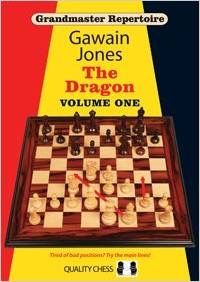Dragon, The
Volume One
Gawain Jones

The Dragon: Volume One by Gawain Jones is a long overdue look at one of the sharpest lines in the Sicilian by a strong Grandmaster. This entire volume is devoted to the Yugoslav Attack (1.e4 c5 2.Nf3 d6 3.d4 cxd4 4.Nxd4 Nf6 5.Nc3 g6 6.Be3 Bg7 7.f3 0-0 8.Qd2 Nc6) and now 9.Bc4 (the bulk of the book) and 9.g4 (Jones likes 9…Be6). The big alternative, 9.0-0-0, is covered in volume two.
The repertoire Jones advocates is based on both the Topalov and Soltis variations. After 9.Bc4 Bd7 10.0-0-0 Rc8 11.Bb3 Nxd4 12.Bxd4 b5 is the Topalov variation. This has several things going for it as it is sound and easy to understand (in ways that some of the Soltis lines are not) and avoids the critical line 10.0-0-0 Rc8 11.Bb3 Ne5 12.Kb1 where White retains flexibility maintaining options of playing in the center as well as the kingside. White can cut off Blacks route to the Topalov with 10.h4 but after 10…h5 11.0-0-0 Rc8 12.Bb3 Black plays 12…Ne5 and Whites early h4 means he has lost flexibility in his position and Black has sidestepped a dangerous possibility (no early h4 with 12.Kb1).
Jones explains all this and more in a clear and easy to read style that makes the long theoretical lines less intimidating. Concrete analysis gets a decided preference, but there is still plenty of explanatory prose to guide the reader. Jones has utilized all available resources including over the board games by top Grandmasters, computer vs. computer battles, e-mail games and most importantly his judgment and analysis.
This book is highly recommended for all who play the Dragon or who are thinking of taking it up. The traditional view has been that the Dragon is for younger players who have the memory and nerves to handle the theory and sharp positions it produces, but long-time American Dragon aficionado Grandmaster Sergey Kudrin has a different take. He believes it serves older players well as the first 15-20 or so moves are played fairly quickly and the following five moves are usually critical in determining the fate of the game. That the critical moments of the game are likely to occur in the second and third hours of play and not later in the game where the veteran is more likely to be fading.
